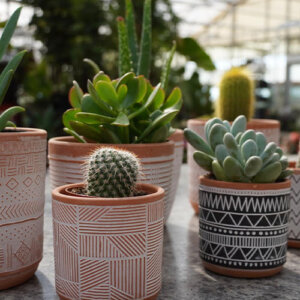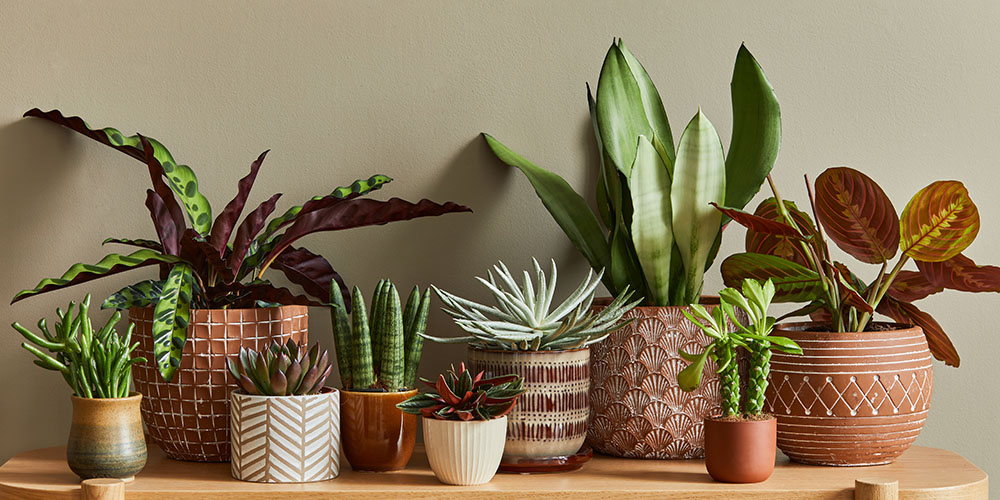Humans take a lot of time deciding which home suits them best, and plants have a preference too! Your houseplants will be happiest and look their best if their pots are a suitable material and size for their needs, along with appropriate drainage. Here’s how to pick the best container for your houseplant.

Pros and Cons of Different Pot Materials
Material matters; not only does the material of a plant pot have a significant aesthetic impact, but it can also affect things like moisture retention, soil temperature, and ease of transplanting. Here are some of the most common container materials you’ll find in garden centers:

Terracotta
The most well-known material for pots, you can spot the signature rusty color of terracotta clay from a mile away. This material is inexpensive and readily available but also very porous, leading to rapid moisture loss. These pots are best for houseplants like succulents and sansevieria, which benefit from quicker moisture evaporation.
Plastic
By far the cheapest houseplant container material, plastic pots are typically more common for houseplants that aren’t on display, like seed starters. However, the advantage of plastic containers is that it’s very easy to remove plants from them when it’s time to size up.

Ceramic
Another extremely popular material for houseplant containers is ceramic. Ceramic pots are beautiful, come in a rainbow of styles and colors, and are usually glazed, which is excellent for moisture retention. However, many ceramic pots don’t have drainage holes, which will require creative problem-solving, which we’ll discuss further.
Fiberglass
These containers combine good looks with practicality; they’re very lightweight, making them perfect for large houseplants, durable, and weather-proof for houseplants that take an annual summer “vacation” outdoors. However, fiberglass is more expensive than other container materials.
Metal
Metal containers have a cool industrial feel, which complements modern decor themes. They’re reasonably priced, great for average water-needs houseplants, durable, and easy to clean. However, metal conducts heat, meaning a metal pot only belongs on the windowsill if the plant prefers high heat units, like cacti. Otherwise, it’s best to use metal pots with houseplants preferring indirect light, which will keep the container from getting too warm.

Concrete
Like metal, concrete has become a popular container material for modern industrial decor enthusiasts. Concrete planters tend to come in geometric forms that are inherently very stable. Their weight can be both a pro and a con; this isn’t a container you’ll want to move around much, but it’s also not likely to tip over easily, especially if the planter has a wide base.
Another drawback is that transplanting a houseplant that has grown out of its concrete planter can be very challenging. Therefore, try to reserve concrete planters for houseplants that have already reached their mature size.
Selecting the Right Size
As your houseplant’s root system grows, it will eventually outgrow its pot. Whether repotting a plant from a decorative pot from its nursery container or simply moving an old favorite from one pot to the next, never size up to a pot more than two inches wider in diameter than the original one. For example, transplant a houseplant that has grown pot bound in a 6-inch pot into an 8-inch pot; this ensures your houseplant receives an appropriate amount of water for its needs.

Does It Drain?
No matter what material your containers may be, drainage is crucial for every houseplant’s good health. Your life (and your plants’!) will be much easier if you select a container with drainage holes that let excess water run out of the bottom. It’s best not to plant a houseplant directly into a pot without drainage holes, which can result in water collecting at the bottom where it can’t escape or evaporate, leading to root rot, fungus gnats, and mold. If you fall in love with a container without drainage holes, you can nest a plastic nursery pot inside and drain it manually or drill drainage holes into the bottom with an appropriate drill bit.
Want more tips on keeping beautiful, healthy potted plants? Chat with our experts at Plant Perfect Garden Center and browse the houseplant containers for sale in Bismarck, ND, today!

